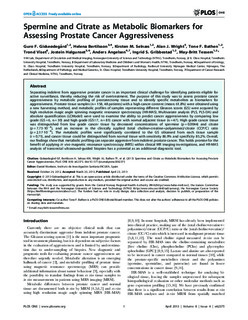| dc.contributor.author | Giskeødegård, Guro F. | |
| dc.contributor.author | Bertilsson, Helena | |
| dc.contributor.author | Selnæs, Kirsten Margrete | |
| dc.contributor.author | Wright, A.J. | |
| dc.contributor.author | Bathen, Tone Frost | |
| dc.contributor.author | Viset, Trond | |
| dc.contributor.author | Halgunset, Jostein | |
| dc.contributor.author | Angelsen, Anders | |
| dc.contributor.author | Gribbestad, Ingrid S | |
| dc.contributor.author | Tessem, May-Britt | |
| dc.date.accessioned | 2015-11-20T11:05:24Z | |
| dc.date.accessioned | 2016-06-02T12:51:23Z | |
| dc.date.available | 2015-11-20T11:05:24Z | |
| dc.date.available | 2016-06-02T12:51:23Z | |
| dc.date.issued | 2013 | |
| dc.identifier.citation | PLoS ONE 2013, 8(4) | nb_NO |
| dc.identifier.issn | 1932-6203 | |
| dc.identifier.uri | http://hdl.handle.net/11250/2391246 | |
| dc.description.abstract | Separating indolent from aggressive prostate cancer is an important clinical challenge for identifying patients eligible for active surveillance, thereby reducing the risk of overtreatment. The purpose of this study was to assess prostate cancer aggressiveness by metabolic profiling of prostatectomy tissue and to identify specific metabolites as biomarkers for aggressiveness. Prostate tissue samples (n = 158, 48 patients) with a high cancer content (mean: 61.8%) were obtained using a new harvesting method, and metabolic profiles of samples representing different Gleason scores (GS) were acquired by high resolution magic angle spinning magnetic resonance spectroscopy (HR-MAS). Multivariate analysis (PLS, PLS-DA) and absolute quantification (LCModel) were used to examine the ability to predict cancer aggressiveness by comparing low grade (GS = 6, n = 30) and high grade (GS≥7, n = 81) cancer with normal adjacent tissue (n = 47). High grade cancer tissue was distinguished from low grade cancer tissue by decreased concentrations of spermine (p = 0.0044) and citrate (p = 7.73·10−4), and an increase in the clinically applied (total choline+creatine+polyamines)/citrate (CCP/C) ratio (p = 2.17·10−4). The metabolic profiles were significantly correlated to the GS obtained from each tissue sample (r = 0.71), and cancer tissue could be distinguished from normal tissue with sensitivity 86.9% and specificity 85.2%. Overall, our findings show that metabolic profiling can separate aggressive from indolent prostate cancer. This holds promise for the benefit of applying in vivo magnetic resonance spectroscopy (MRS) within clinical MR imaging investigations, and HR-MAS analysis of transrectal ultrasound-guided biopsies has a potential as an additional diagnostic tool. | nb_NO |
| dc.language.iso | eng | nb_NO |
| dc.publisher | Public Library of Science | nb_NO |
| dc.rights | Navngivelse 3.0 Norge | * |
| dc.rights.uri | http://creativecommons.org/licenses/by/3.0/no/ | * |
| dc.title | Spermine and Citrate as Metabolic Biomarkers for Assessing Prostate Cancer Aggressiveness | nb_NO |
| dc.type | Journal article | nb_NO |
| dc.type | Peer reviewed | nb_NO |
| dc.date.updated | 2015-11-20T11:05:24Z | |
| dc.source.volume | 8 | nb_NO |
| dc.source.journal | PLoS ONE | nb_NO |
| dc.source.issue | 4 | nb_NO |
| dc.identifier.doi | 10.1371/journal.pone.0062375 | |
| dc.identifier.cristin | 1034937 | |
| dc.description.localcode | © 2013 Giskeødegård et al. This is an open-access article distributed under the terms of the Creative Commons Attribution License, which permits unrestricted use, distribution, and reproduction in any medium, provided the original author and source are credited. | nb_NO |

